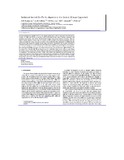| dc.description.abstract | Stratabound epigenetic sulphide Zn–Pb–Cu ore deposits of the Central African Copperbelt in the Democratic
Republic of Congo and Zambia are mostly hosted in deformed shallow marine platform carbonates and
associated sedimentary rocks of the Neoproterozoic Katanga Supergroup. Economic orebodies, that also
contain variable amounts of minor Cd, Co, Ge, Ag, Re, As, Mo, Ga, and V, occur mainly as irregular pipe-like
bodies associated with collapse breccias and faults as well as lenticular bodies subparallel to bedding. Kipushi
and Kabwe in the Democratic Republic of the Congo and Zambia, respectively, are the major examples of
carbonate-hosted Zn–Pb–Cu mined deposits with important by-products of Ge, Cd, Ag and V in the Lufilian
Arc, a major metallogenic province famous for its world-class sediment-hosted stratiform Cu–Co deposits.
The carbonate-hosted deposits range in age from Neoproterozoic to early Palaeozoic (680 to 450 Ma). The
formation of the relatively older Neoproterozoic deposits is probably related to early collision events during
the Lufilian Orogeny, whereas the younger Palaeozoic deposits may be related to post-collisional processes of
ore formation. Fluid inclusion and stable isotope data indicate that hydrothermal metal-bearing fluids
evolved from formation brines during basin evolution and later tectonogenesis. Ore fluid migration occurred
mainly along major thrust zones and other structural discontinuities such as karsts, breccias and faults within
the Katangan cover rocks, resulting in ore deposition within favourable structures and reactive carbonates of
the Katangan Supergroup. | en_US |

